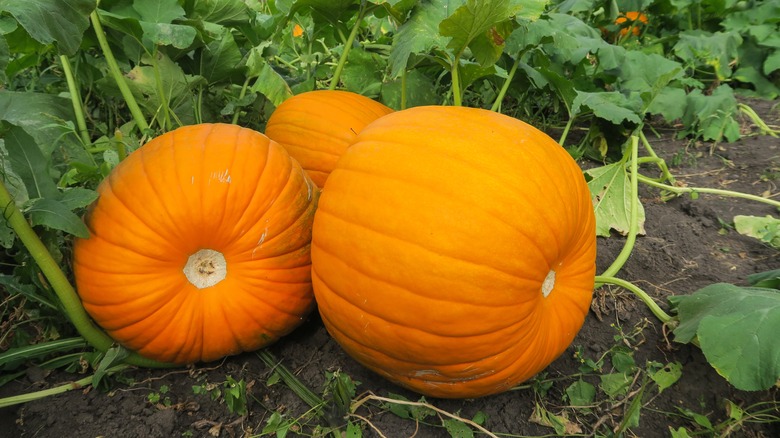Is Milk The Secret To Growing Big, Healthy Pumpkins? Here's What We Know
If you've ever dreamed about harvesting your very own pumpkin-zilla but struggled to grow any larger than a beach ball, you may have heard that milk could provide you with incredible results. Milk is rumored to be key in growing some seriously giant gourds. However, this theory stems more from garden gossip and isn't fully supported by the horticulture community. Some claim that, due to its calcium content, milk can strengthen the fruit's cell walls and may prevent issues like blossom end rot. Some anecdotal evidence even suggests that spraying this beverage on pumpkin leaves might help control fungal diseases like powdery mildew.
However, while many human beings consume milk on a daily basis, watering your plants with milk doesn't fully make sense. Plants don't absorb nutrients the way that flesh and blood bodies do. The harsh reality is that injecting this liquid into your pumpkin's vines, which are essentially its veins, could possibly cause it to rot, which is not what you want to do. That being said, a solution of milk and water used in moderation could give a minor boost to your gourd. Just remember that too much of a good thing can end up with rotten results.
Methods for milk-feeding your pumpkins
There are two main ways you can feed your pumpkin's milk. The simplest method is to simply mix and pour a solution of milk and water directly onto the soil surrounding the base of the plant so that the roots can absorb the nutrients. As discussed, this method may also be safer for your pumpkins than the alternative, which is the IV method. This would provide essential nutrients to the pumpkin intravenously.
To prepare the plant for the IV method, start by selecting a healthy vine that has the potential to yield a massive pumpkin. To make sure it receives all the nutrients without any sibling rivalry, eliminate all but one healthy blossom from the vine. Make a precise, shallow 1 to 2 inch cut about halfway through the vine, between the base of the plant and the blossom. Do not split open the vine, and do not shove the wick into the vine haphazardly. You can use a small screwdriver or another probing device to gently insert the wick into the slit. Once the wick is securely placed, bandage the cut to secure the wick and protect the wound from pests. To set up a milk source for the pumpkin plant, place a jar filled with milk under the slit and dip the wick inside. The pumpkin will absorb the milk through the wick. Be sure to check on the milk levels throughout the growing season.
Better ways to grow healthy pumpkins
Contrary to what circulates on the internet, feeding milk to your pumpkins is not really a recommended practice. The misconception that a majority of pumpkin gardeners use this hack to produce big, beautiful cucurbits may stem from a book written by Laura Ingalls Wilder called "Farmer's Boy," where one of her characters grows an award-winning gourd by intravenously feeding it milk. While using milk as fertilizer is still up in the air, there are a few other things you can do to bolster your rotund gourd.
Selecting the appropriate variety is the most obvious, as some pumpkins have been bred especially to produce some seriously seismic fruit. Additionally, you'll want to make sure that your pumpkin baby is growing in nutrient rich and properly fertilized soil. Because of this, before planting, measure the soil's pH level. Garden gurus note that burying the early section of the vine in the soil will help the pumpkin develop more roots, which will improve the plant's ability to absorb nutrients. Finally, simply providing the plant with adequate water, sunlight, and space could produce a pumpkin that looks like it was plucked straight out of the 1966 classic, "It's the Great Pumpkin, Charlie Brown."

